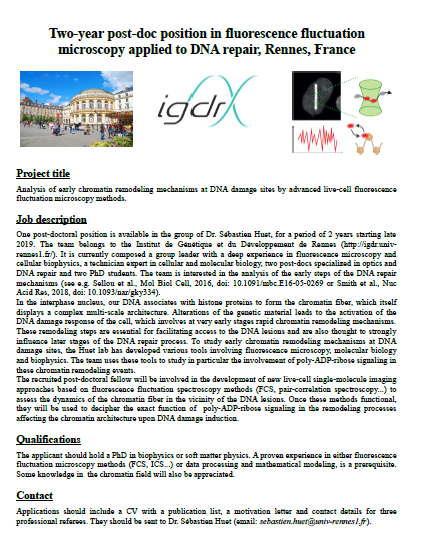Two-year post-doc position in fluorescence fluctuation microscopy applied to DNA repair, Rennes, France

Project title
Analysis of early chromatin remodeling mechanisms at DNA damage sites by advanced live-cell fluorescence
fluctuation microscopy methods.
Job description
One post-doctoral position is available in the group of Dr. Sébastien Huet, for a period of 2 years starting late 2019. The team belongs to the Institut de Génétique et du Développement de Rennes (http://igdr.univrennes1.fr/). It is currently composed a group leader with a deep experience in fluorescence microscopy and cellular biophysics, a technician expert in cellular and molecular biology, two post-docs specialized in optics and DNA repair and two PhD students. The team is interested in the analysis of the early steps of the DNA repair mechanisms (see e.g. Sellou et al., Mol Biol Cell, 2016, doi: 10.1091/mbc.E16-05-0269 or Smith et al., Nuc Acid Res, 2018, doi: 10.1093/nar/gky334).
In the interphase nucleus, our DNA associates with histone proteins to form the chromatin fiber, which itself displays a complex multi-scale architecture. Alterations of the genetic material leads to the activation of the DNA damage response of the cell, which involves at very early stages rapid chromatin remodeling mechanisms. These remodeling steps are essential for facilitating access to the DNA lesions and are also thought to strongly influence later stages of the DNA repair process. To study early chromatin remodeling mechanisms at DNA damage sites, the Huet lab has developed various tools involving fluorescence microscopy, molecular biology and biophysics. The team uses these tools to study in particular the involvement of poly-ADP-ribose signaling in these chromatin remodeling events.
The recruited post-doctoral fellow will be involved in the development of new live-cell single-molecule imaging approaches based on fluorescence fluctuation spectroscopy methods (FCS, pair-correlation spectroscopy…) to assess the dynamics of the chromatin fiber in the vicinity of the DNA lesions. Once these methods functional,
they will be used to decipher the exact function of poly-ADP-ribose signaling in the remodeling processes affecting the chromatin architecture upon DNA damage induction.
For additional information please check the job offer.